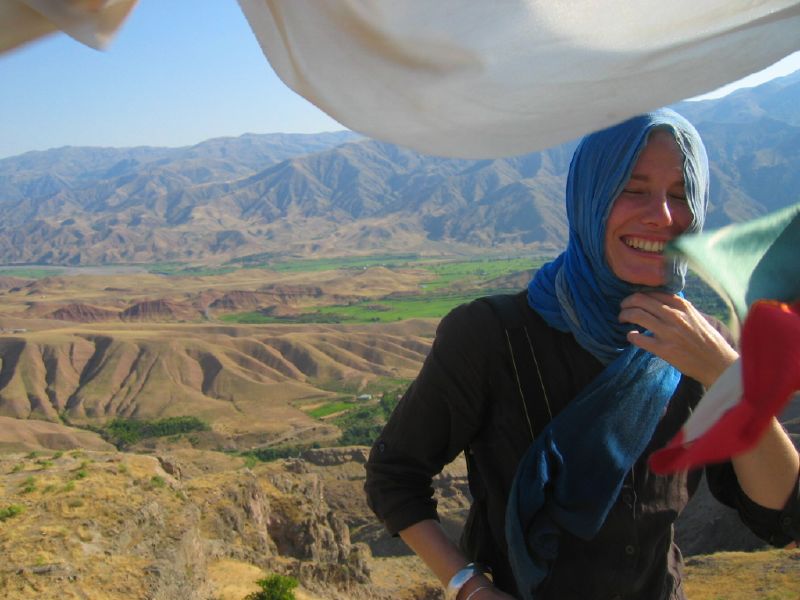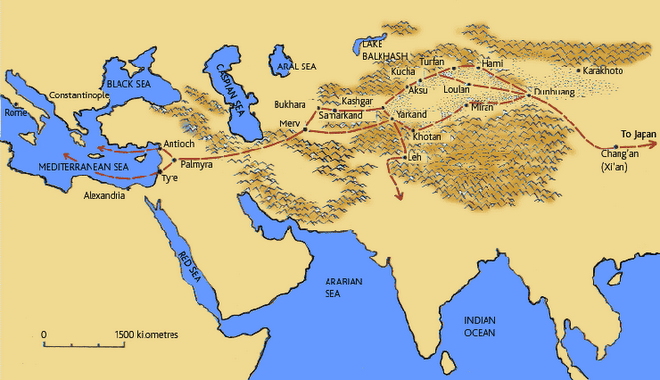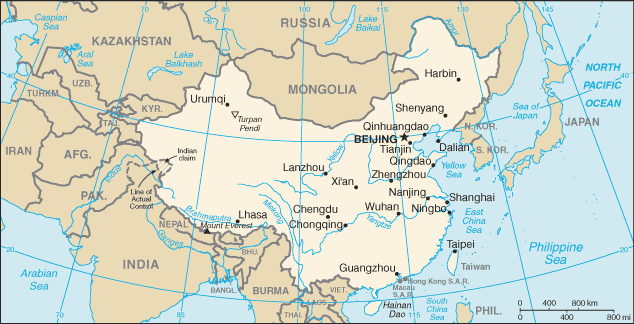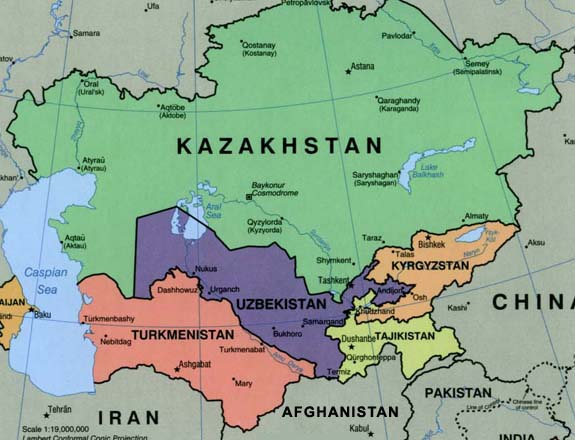Waiting at the Kyrgyz/Uzbek border at Osh, I write in my notebook: crossing into new worlds, leaps and jumps in one place – we are turning in circles. Repeating steps in madness trying to get some perspective on these - the dents and contours of the earth, the finer wrinkles of the world: appealing, sensual. Inscribed upon them, the symphony of human lives, the texture and geometry of histories. And here these gunmen standing in the middle of the plain demanding a halt. Crossing the border, I feel like a fugitive, walking in front of a firing squad. There is a tension here in the straight shot – a road punctuated by barbed wires – and one metal hut where all is determined: in or out. Passing into Uzbekistan is about negotiating with gangsters.
Uzbekistan feels like a land under cover, tightly sealed for better control. I’m not used to these military check-points, these guns held as if they carried the reason of the world. I’m uncomfortable with the endless waves of policemen that walk the streets. After a long, although harmless interrogation by a policeman at a road block, I learn to never catch a soldier’s eye.
And then, after the border checks, the road-blocks and the fear – you reach places like Mutalibjan’s office in the Andijan Hunarmand (hand-made) Association, and you pause for sugared tea and conversation. Here you can sink into the country – the hospitable gestures of its people.
Crafts, Markets and Warriors
Mutalibjan’s office is wall to wall color, draped in Suzanni – the traditional colorful embroidery of Uzbekistan, wood carvings, dolls, pottery. He points to all the over-load of creations scattered among the desk and the walls and says, “In the Ferghana Valley we have a multitude of craftsmen, but we have no tourists.” He means no market for the crafts. Here in Uzbekistan tourism has enabled a booming of traditional crafts, but that market is focused around the blue-tiled concentrate of Samarkand and Bukhara, and the Ferghana Valley remains in the shadow. Fear of political instability and the valley’s bad-rap (domestically and internationally) means that no tourist structures are being built up here – so that the shadow seems like it will darken its outline at least for the short-term.
But in shadow, warriors rise. Mutalibjan shares his office with Mansura Yusupova, a dynamic, boisterous fireball of a woman. She is the (natural) head of the Hunarmand Association. Full of life, but tough - Mansura is clearly in charge. She carries the flame and she is up for a challenge.
Taxes
The Andijan Hunarmand Association was created in 1997, by the Uzbek president Islam Karimov himself. In a gesture of goodwill to the international community and supposedly on the advice of UNESCO’s then country director, in 1997 Karimov granted craftsmen in Uzbekistan a complete exemption from taxes. This was seen as a very strong gesture to encourage, promote and revive crafts in the country. Regional organizations were then created to handle the registration and administrative tasks the new law entailed. In Andijan alone 810 craftsmen registered with the Hunarmand Crafts Organization.
Crafts in Uzbekistan have gained recognition – from tourists and the government. Crafts once received much attention from international organizations – but the work of those organizations has been greatly hampered if not fully halted by the government’s clamp down on international NGOs and organization in retaliation for the wide international criticism Karimov received over the Andijan riots.
The streets of Andijan…..craftsmen in the bazaar. committee of 10 people who decide which craftsmen to promote. (who falls between) there are craftsmen still making the tools used by people – and next to the craftsmen association is a row jam-packed with metal workers, making doors, blacksmiths and wooden furniture makers.
Bridging Markets
Mansura has been the head of the Andijan Hunarmand Organization since 2000. Her work with Mutalibjan focuses on promoting local artisans to those cities beyond the valley. They are busy training and advising local craftsmen on the particular demands of tourists who travel to Samarkand and Bukhara. They are go-betweens, mediators between the makers and their distant market. Mansura has revived crafts for which she senses a market – like Nuriddin Khotamov’s traditional leather and embroidered silk shoes. She has also started a papier-mâché doll business of her own. Both businesses are working, and I will see the same shoes and dolls sold throughout the country. Nuriddin’s shoes have won a Seal of Excellence award from UNESCO.
Mansura graduated from university where she studied to be an art critic. From 1987 to 2000 she worked in the Literary and Art Museum of Andijan. Today she’s just come back from an exhibition in France organized by the Uzbek embassy in Paris. She’s excited to use her few words of French, and calls me mademoiselle. She is clearly a full-blown business woman, and talks in numbers and orders: 200 Suzannis for a businessman she met in France, 20 small and 20 large dolls for an upcoming exhibition in Samarkand. She talks about crafts frankly, she’s straight to the point: “Business is the driver behind the survival of traditional crafts,” she says. “If craftsmen can only sell two or three pieces of their work, then interest is lost and the craft disappears.”
She sees her work as creating markets – and she’s got personal interest vested in the success of her endeavors. She not only makes dolls, but also creates Suzannis, bags, pillows, and clothes. She employs almost 100 women to hand-make her creations, which she then sells to markets in Samarkand, Bukhara and if she can, abroad. She says that many women come to her looking for jobs. “Their husbands don’t let them work all day,” she says, “but the work they do helps their families financially.” Mansura says that she’s an artist. She’s an artist with an intuitive MBA.
Mutalibjan stands in retreat, he is shy, but his face is open and he is soft spoken. Before the collapse of the Soviet Union he taught automobile repair in a technical college. But he comes from a family of professional weavers: silk and cotton weavers. The Soviets had prohibited home-made weaving, but his family continued secretly and he learned the trade concealed behind the door of his family home. He tells me that there were serious reprimands for those caught continuing this kind of home production – which directly competed against the local factories. Some weavers he knew were imprisoned for their boldness. Although he is nostalgic about the Soviet Union and regrets its collapse, he says that there was a clear repression of the valley’s traditional ways of life. “If the Soviet Union had lasted twenty more years, the knowledge of crafts would have disappeared altogether.” He says that the Soviets gave craftsmen a brutal, almost fatal blow. The market and social structures of the USSR did not support the traditional locally-based craft economies.
After the collapse of the Soviet Union, the technical school at which Mutalibjan worked stopped distributing salaries. It was equivalent to unemployment. Faced with a blisteringly depressed job-market, Mutalibjan went back to the skills he knew: weaving. “We weren’t happy to start this traditional work again, but we had no choice.” It was slow languorous work and local people refused to buy the hand-made cloth, whose price was unable to compete with the cheaper China-made alternatives. “People don’t buy traditional, they want modern,” Mutalibjan says. After attending an NGO-sponsored seminar on how to write grant proposals, Mutalibjan and his family won a support grant from the Soros Foundation in 2003 – just before the organization was ejected from Uzbekistan, like so many others. The grant helped to support the family’s traditional weaving for a while, but unable to compete with Marghilan’s weaving and with no real desire to continue, the family has stopped weaving altogether.
There is a fierceness, a boldness required to succeed in the crafts market here. It is not enough to make high-quality pieces; the craftsmen need a marketer’s ruthlessness and business creativity.
But Mutalibjan has a grace, a shy beautiful smile, and an easy connection with people – one that I will see in action over the next few days spent with him, as he introduces me to artisans in and around Andijan. He and Mansura are opposites that match – and the craftsmen of Andijan are lucky for their effective teamwork.





No comments:
Post a Comment